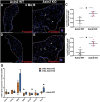Loss of Axin2 results in impaired heart valve maturation and subsequent myxomatous valve disease
- PMID: 28069701
- PMCID: PMC5220675
- DOI: 10.1093/cvr/cvw229
Loss of Axin2 results in impaired heart valve maturation and subsequent myxomatous valve disease
Abstract
Aims: Myxomatous valve disease (MVD) is the most common aetiology of primary mitral regurgitation. Recent studies suggest that defects in heart valve development can lead to heart valve disease in adults. Wnt/β-catenin signalling is active during heart valve development and has been reported in human MVD. The consequences of increased Wnt/β-catenin signalling due to Axin2 deficiency in postnatal valve remodelling and pathogenesis of MVD were determined.
Methods and results: To investigate the role of Wnt/β-catenin signalling, we analysed heart valves from mice deficient in Axin2 (KO), a negative regulator of Wnt/β-catenin signalling. Axin2 KO mice display enlarged mitral and aortic valves (AoV) after birth with increased Wnt/β-catenin signalling and cell proliferation, whereas Sox9 expression and collagen deposition are decreased. At 2 months in Axin2 KO mice, the valve extracellular matrix (ECM) is stratified but distal AoV leaflets remain thickened and develop aortic insufficiency. Progressive myxomatous degeneration is apparent at 4 months with extensive ECM remodelling and focal aggrecan-rich areas, along with increased BMP signalling. Infiltration of inflammatory cells is also observed in Axin2 KO AoV prior to ECM remodelling. Overall, these features are consistent with the progression of human MVD. Finally, Axin2 expression is decreased and Wnt/β-catenin signalling is increased in myxomatous mitral valves in a murine model of Marfan syndrome, supporting the importance of Wnt/β-catenin signalling in the development of MVD.
Conclusions: Altogether, these data indicate that Axin2 limits Wnt/β-catenin signalling after birth and allows proper heart valve maturation. Moreover, dysregulation of Wnt/β-catenin signalling resulting from loss of Axin2 leads to progressive MVD.
Keywords: Axin2 • Heart valve development • Myxomatous valve disease • ECM remodelling • Wnt/β-catenin signalling.
Published on behalf of the European Society of Cardiology. All rights reserved. © The Author 2016. For Permissions, please email: journals.permissions@oup.com.
Figures







Comment in
-
Increased canonical WNT/β-catenin signalling and myxomatous valve disease.Cardiovasc Res. 2017 Jan;113(1):6-9. doi: 10.1093/cvr/cvw236. Cardiovasc Res. 2017. PMID: 28069697 Free PMC article. No abstract available.
References
-
- Mozaffarian D, Benjamin EJ, Go AS, Arnett DK, Blaha MJ, Cushman M, Das SR, de Ferranti S, Despres JP, Fullerton HJ, Howard VJ, Huffman MD, Isasi CR, Jimenez MC, Judd SE, Kissela BM, Lichtman JH, Lisabeth LD, Liu S, Mackey RH, Magid DJ, McGuire DK, Mohler ER, 3rd, Moy CS, Muntner P, Mussolino ME, Nasir K, Neumar RW, Nichol G, Palaniappan L, Pandey DK, Reeves MJ, Rodriguez CJ, Rosamond W, Sorlie PD, Stein J, Towfighi A, Turan TN, Virani SS, Woo D, Yeh RW, Turner MB, American Heart Association Statistics C, Stroke Statistics S. Heart disease and stroke statistics-2016 update: a report from the American Heart Association. Circulation 2016;133:e38–e360. - PubMed
-
- Geirsson A, Singh M, Ali R, Abbas H, Li W, Sanchez JA, Hashim S, Tellides G. Modulation of transforming growth factor-beta signaling and extracellular matrix production in myxomatous mitral valves by angiotensin II receptor blockers. Circulation 2012;126:S189–S197. - PubMed
-
- Sainger R, Grau JB, Branchetti E, Poggio P, Seefried WF, Field BC, Acker MA, Gorman RC, Gorman JH, 3rd, Hargrove CW, 3rd, Bavaria JE, Ferrari G. Human myxomatous mitral valve prolapse: role of bone morphogenetic protein 4 in valvular interstitial cell activation. J Cell Physiol 2012;227:2595–2604. - PMC - PubMed
-
- Caira FC, Stock SR, Gleason TG, McGee EC, Huang J, Bonow RO, Spelsberg TC, McCarthy PM, Rahimtoola SH, Rajamannan NM. Human degenerative valve disease is associated with up-regulation of low-density lipoprotein receptor-related protein 5 receptor-mediated bone formation. J Am Coll Cardiol 2006;47:1707–1712. - PMC - PubMed
Publication types
MeSH terms
Substances
Grants and funding
LinkOut - more resources
Full Text Sources
Other Literature Sources
Medical
Molecular Biology Databases
Research Materials

